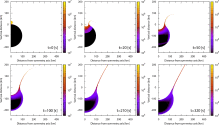Collisional disruption of planetesimals in the gravity regime with iSALE code: Comparison with SPH code for purely hydrodynamic bodies
Collisional disruption of planetesimals in the gravity regime with iSALE code: Comparison with SPH code for purely hydrodynamic bodies
Suetsugu, Ryo; Tanaka, Hidekazu; Kobayashi, Hiroshi; Genda, Hidenori
Publication:Icarus, Volume 314, p. 121-132.
Pub Date:November
2018DOI:10.1016/j.icarus.2018.05.027
In most of the previous studies related to collisional disruption of planetesimals in the gravity regime, Smoothed Particle Hydrodynamics (SPH) simulations have been used. On the other hand, impact simulations using grid-based hydrodynamic code have not been sufficiently performed. In the present study, we execute impact simulations in the gravity regime using the shock-physics code iSALE, which is a grid-based Eulerian hydrocode. We examine the dependence of the critical specific impact energy QRD* on impact conditions for a wide range of specific impact energy (QR) from disruptive collisions to erosive collisions, and compare our results with previous studies. We find that collision outcomes of the iSALE simulation agree well with those of the SPH simulation. Detailed analysis mainly gives three results. (1) The value of QRD* depends on numerical resolution, and is close to convergence with increasing numerical resolution. The difference in converged value of QRD* between the iSALE code and the SPH code is within 30%. (2) Ejected mass normalized by total mass (Mej/Mtot) generally depends on various impact conditions. However, when QR is normalized by QRD*that is calculated for each impact simulation, Mej/Mtot can be scaled by QR / QRD*, and is independent of numerical resolution, impact velocity and target size. (3) This similarity law for QR / QRD* is confirmed for a wide range of specific impact energy. We also derive a semi-analytic formula for QRD* based on the similarity law and the crater scaling law. We find that the semi-analytic formula for the case with a non-porous object is consistent with numerical results.

